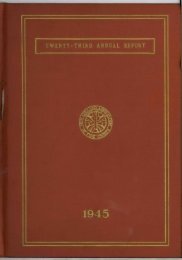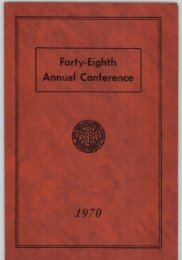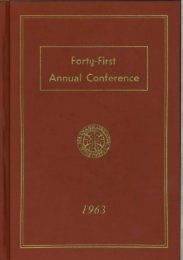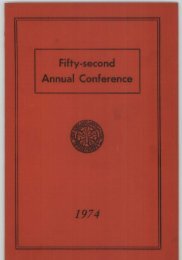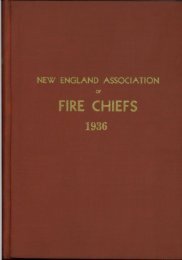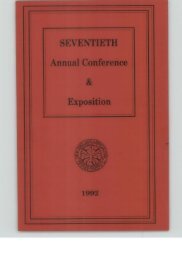NEAFC 31st Annual Conference.pdf - New England Association of ...
NEAFC 31st Annual Conference.pdf - New England Association of ...
NEAFC 31st Annual Conference.pdf - New England Association of ...
You also want an ePaper? Increase the reach of your titles
YUMPU automatically turns print PDFs into web optimized ePapers that Google loves.
NEW ENGLAND ASSOCIATION OF FIRE CHIEFS<br />
THE FIRE AND EXPLOSION HAZARDS OF GASEOUS, FUELS<br />
Consulting Mechanical Engineer<br />
In the ~Nor-theastern States natural gas is only six years ol& Nevertheless, on<br />
the record already available, it seems indisputable that-it <strong>of</strong>fers a potential threat to<br />
life and property <strong>of</strong> sufficient magnitude to warrant prominence on your list <strong>of</strong> local<br />
fire and explesion hazards.<br />
In .order to fully reali;ze the problems involved, it is necessary first to review, even<br />
if o~Ay sketchily, the rapid growth <strong>of</strong> the natural gas industry.<br />
Less than thirty years ago less than 4% <strong>of</strong> the total requirements <strong>of</strong> the United<br />
States were supplied by natural gas; and even this was distributed on a purely local<br />
basis. Within this period, production increased over seven fold until natural gas now<br />
supplies c.ver 20% <strong>of</strong> our now greatly augmented energy needs through a network <strong>of</strong><br />
well over 200,000 miles <strong>of</strong> transmission lines.<br />
Only six years ago, the conversion <strong>of</strong> the "big inch" and "little inch" lines to<br />
natural gas marked the introduction <strong>of</strong> this fuel. into the Northeastern States; today<br />
the amount distributed northeast <strong>of</strong> Washington, D. C., by three companies ~alone,<br />
parallels the entire annual energy production <strong>of</strong> the anthracite industry.<br />
This expansion and construction is by r~o means over. In fact, the Petroleum<br />
Administration for Defense has just predicted that by 19~.y, over 94% <strong>of</strong> all gas<br />
distributed to the ultimate consumer will consis< either all or in part, <strong>of</strong> natural g~s.<br />
They further predict that almost 10 million tons <strong>of</strong> new pipe lines will be laid’in the:<br />
next three years, and that over 70% <strong>of</strong> this new pipe will be over 16" in diameter.<br />
A close connection is seen between this rapid, and at times almost .frantic, growth<br />
<strong>of</strong> the natural gas industry and a failure to institute higher standards <strong>of</strong> safety in con;<br />
struction and operation. A code designed in 1942 for gas transmission lines proved<br />
adequate for the mesquite prairie crossings constituting most <strong>of</strong> the pre-war construction;<br />
but it seems unfortunate that it was not more drastically changed when<br />
larger diameter pipe lines began to traverse valuable .sn.burban properties, closely knit<br />
farms, and even urban communities.<br />
As a result we find that transmission lines are being built in such areas with<br />
factors-<strong>of</strong>-safety that are only a fraction <strong>of</strong> those considered standard for other comparable<br />
pipes designed to carry high pressure fluids. Other precautions normally taken<br />
during orderly construction are <strong>of</strong>ten thrown to the winds in the haste to complete<br />
lines in a minimum <strong>of</strong> time and at the lowest possible cost. Dumping pipes from cars<br />
and trucks is a frequent example, despite the fully recognized hazard <strong>of</strong> even a deep<br />
scratch to vessels carrying a full pressure load. One company has twice admitted in<br />
court, in my presence, that their 16" pipe laid in the open for over a year without any<br />
protection from the weather before being used. Even when questionedl as to the bursting<br />
strength <strong>of</strong> the pipe being used, company engineers usually refer to general test<br />
codes instead <strong>of</strong> citing from specific tests on the pipe at hand.<br />
Even granting proper design and construction, there .are two separate and distinct<br />
hazards in connection with the operation <strong>of</strong> natural gas lines, the mechanical<br />
bursting <strong>of</strong> the pipe due to internal pressures in excess <strong>of</strong> its strength, and the ignition<br />
<strong>of</strong> explosive mixtures contained therein.



